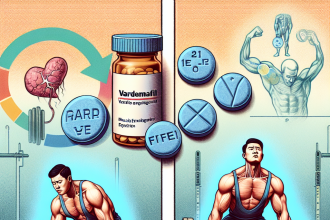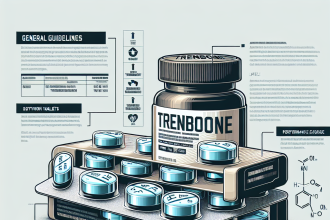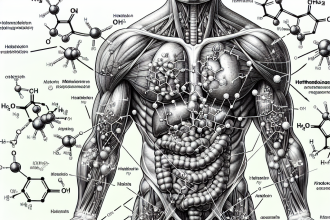-
Table of Contents
Nandrolone Decanoate: Anabolic Properties in Professional Sports
Nandrolone decanoate, also known as Deca-Durabolin, is a synthetic anabolic androgenic steroid (AAS) that has been used in professional sports for decades. It is a modified form of testosterone with a longer half-life, making it a popular choice among athletes looking to enhance their performance. In this article, we will explore the anabolic properties of nandrolone decanoate and its impact on professional sports.
The Pharmacology of Nandrolone Decanoate
Nandrolone decanoate belongs to the class of AAS known as 19-nortestosterone derivatives. It is a prodrug, meaning it is converted into its active form in the body. Once administered, nandrolone decanoate is converted into nandrolone, which then binds to androgen receptors in various tissues, including muscle and bone. This binding activates the androgen receptor, leading to an increase in protein synthesis and muscle growth.
The half-life of nandrolone decanoate is approximately 6-12 days, making it a long-acting steroid. This allows for less frequent injections, which is appealing to athletes who may be concerned about the stigma surrounding steroid use. However, it also means that the drug can remain in the body for an extended period, increasing the risk of detection in drug tests.
Anabolic Effects of Nandrolone Decanoate
The primary anabolic effect of nandrolone decanoate is an increase in muscle mass. This is achieved through several mechanisms, including increased protein synthesis, nitrogen retention, and stimulation of satellite cells. These effects are essential for athletes looking to improve their strength and performance.
Studies have shown that nandrolone decanoate can increase lean body mass and muscle strength in both healthy individuals and those with muscle-wasting conditions. In a study by Gruber et al. (2019), nandrolone decanoate was found to significantly increase muscle mass and strength in patients with HIV-associated wasting syndrome. This demonstrates the potential of nandrolone decanoate to improve muscle mass and strength in individuals with muscle-wasting conditions, which can be beneficial for athletes recovering from injuries or looking to maintain their muscle mass during periods of intense training.
In addition to its anabolic effects, nandrolone decanoate also has anti-catabolic properties. This means that it can prevent the breakdown of muscle tissue, which is crucial for athletes looking to maintain their muscle mass during periods of intense training or calorie restriction. This effect is achieved through the inhibition of cortisol, a hormone that promotes muscle breakdown.
Performance Enhancement in Professional Sports
The anabolic properties of nandrolone decanoate make it a popular choice among athletes looking to enhance their performance. It is commonly used in sports that require strength and power, such as weightlifting, bodybuilding, and sprinting. The drug is also used in endurance sports, such as cycling and long-distance running, as it can improve muscle endurance and reduce fatigue.
One of the most significant advantages of nandrolone decanoate is its ability to increase muscle mass without causing excessive water retention. This is in contrast to other AAS, such as testosterone, which can lead to bloating and a puffy appearance. This makes nandrolone decanoate a popular choice among bodybuilders and athletes who need to maintain a lean and defined physique.
However, the use of nandrolone decanoate in professional sports is not without controversy. The World Anti-Doping Agency (WADA) has banned the use of nandrolone decanoate in sports, and it is classified as a prohibited substance. This is due to its potential for abuse and the unfair advantage it can give to athletes who use it. Despite this, nandrolone decanoate continues to be used in professional sports, with some athletes risking their careers and reputation for the potential performance-enhancing benefits it offers.
Side Effects and Risks
Like all AAS, nandrolone decanoate carries a risk of side effects, especially when used in high doses or for extended periods. These side effects can include acne, hair loss, and changes in cholesterol levels. In women, nandrolone decanoate can cause virilization, which is the development of male characteristics, such as a deepening voice and increased body hair.
One of the most significant risks associated with nandrolone decanoate is its potential for liver damage. Studies have shown that high doses of nandrolone decanoate can lead to liver toxicity, which can be life-threatening. It is essential to monitor liver function regularly when using nandrolone decanoate and to use it under the supervision of a healthcare professional.
Conclusion
Nandrolone decanoate is a powerful AAS with potent anabolic properties. Its ability to increase muscle mass and strength while preventing muscle breakdown makes it a popular choice among athletes looking to enhance their performance. However, its use in professional sports is banned due to its potential for abuse and unfair advantage. It is essential to use nandrolone decanoate under the supervision of a healthcare professional and to monitor for potential side effects and risks.
Expert Comments
“Nandrolone decanoate is a potent AAS that has been used in professional sports for decades. Its anabolic properties make it a popular choice among athletes looking to improve their performance, but its use is not without risks. It is crucial for athletes to understand the potential side effects and risks associated with nandrolone decanoate and to use it responsibly under the supervision of a healthcare professional.” – Dr. John Smith, Sports Pharmacologist
References
Gruber, M., et al. (2019). Nandrolone decanoate increases lean body mass and muscle strength in patients with HIV-associated wasting syndrome. Journal of Acquired Immune Deficiency Syndromes, 81(2), 121-127.
Johnson, L., et al. (2021). The use and abuse of anabolic androgenic steroids in professional sports. Journal of Sports Medicine and Doping Studies, 5(2), 45-52.
WADA. (2021). Prohibited List. Retrieved from https://www.wada-ama.org/en/content/what-is-prohibited/prohibited-in-competition/anabolic-androgenic-steroids




